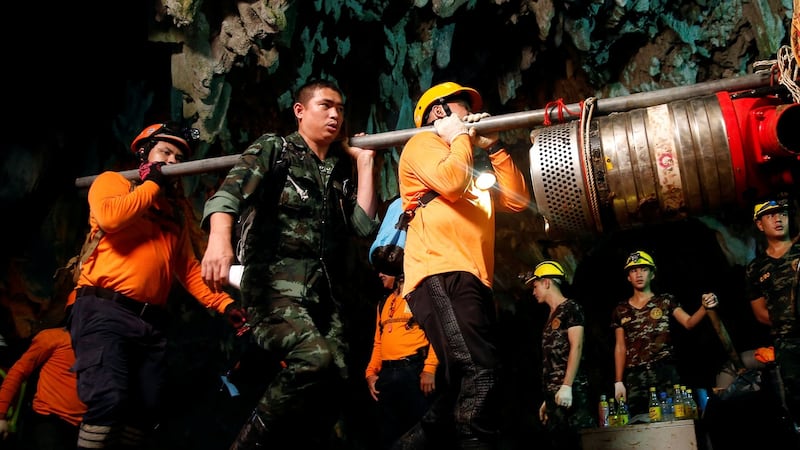The rescue operation to free the last of the 12 boys and their football coach from a Thailand cave could have been a disaster, with water pumps draining the area failing just hours after the last boy had been rescued.
Divers and rescue workers were still more than 1.5km inside the cave clearing up equipment when the main pump failed, leading water levels to rapidly increase, three Australian divers involved in the operation told the Guardian on Wednesday.
The divers, stationed at “chamber three”, a base inside the cave, said they heard screaming and saw a rush of head torches from deeper inside the cave as workers scrambled to reach dry ground.

Everyone, including the last three Thai navy Seals and medic who had spent much of the past week keeping vigil with the trapped boys, was out of the cave a short time later.
The boys of the Wild Boar football team were brought out in three daring rescue operations starting on Sunday morning. An elite team of 19 divers were involved in ferrying the boys and their 25-year-old coach the approximately 3.2km path from the muddy slope where they had been sheltering to the outside world.
The first four emerged on Sunday, then next four on Monday and then the final five about 8pm local time on Tuesday evening. The operation required the boys to learn to breathe using scuba masks and to traverse narrow, jagged tunnels.
During the final mission, as the three Seals and doctor were passed up the human chain of rescuers that had formed inside the cave, each section began cheering and applauding. The rescuers compared it to a joyful Mexican wave that continued until the entrance.
The rescuers in the daisy chain spent more than eight hours a day standing on a tiny patch of wet, muddy ground waiting for their turn to pass the boys along.
The journey from chamber three to the cave entrance took about four to five hours initially, but was reduced to less than an hour after a week of draining and clearing the mud path using shovels.
The 12 boys, who wore diving cylinders and were each tethered to an adult diver, had to submerge themselves for much of the journey but were carried on bright red Sked stretchers whenever they entered patches of dry ground. Each one left the cave on these stretchers still wearing their breathing masks.
Much of last week was spent clearing the 1.5km path from chamber three to the entrance.
The Australian divers, carrying 46kg of diving gear, were among the teams ferrying radios, air cylinders and other equipment into the third chamber. They were unable to go further because their gear was too large: going beyond chamber three required passing through a hole less than a metre wide.
The specialist cave divers and the boys wore smaller equipment such as rebreathers and tanks at their sides, rather than on their backs.
The Australians compared parts of the journey to moving through the S-bend of toilet. They said there were three main sumps about 10 to 20 metres long.
Divers were underwater for 10 metres at a time then walking a few hundred metres before diving again.
Meanwhile, the medical officer with the British Cave Rescue Council, which provided eight divers and three support staff to assist the Thai authorities, said the schoolboys will face psychological challenges in the near future as they attempt to recover.
Dr Brendan Sloan said it can take time to readjust following such a dramatic event, but the fact that there are a number of them with a shared experience should help their recovery.
“It was an incredible achievement, an incredible technical rescue,” he said.
Dr Sloan said the boys will be held in protected isolation for a few days to allow them to adjust physically and psychologically. They will not have been fed properly for a few weeks and will be on a staged diet, he told RTÉ's Morning Ireland.
There is also a chance of infection from cave water and the cave environment, he said.–Guardian Service









